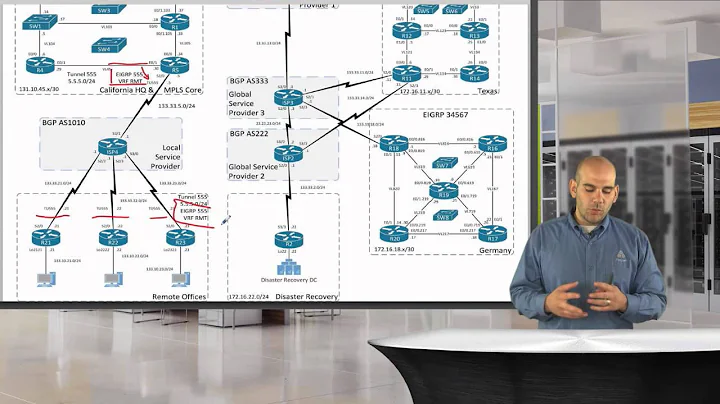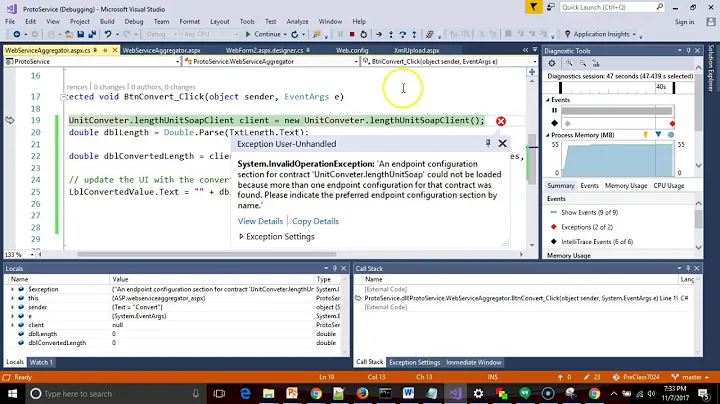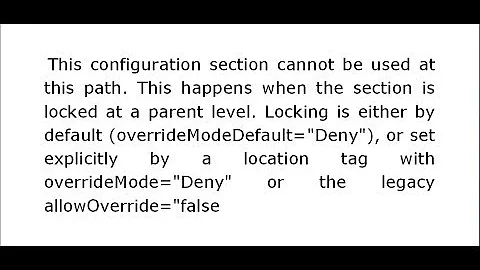How to implement a ConfigurationSection with a ConfigurationElementCollection
Solution 1
The previous answer is correct but I'll give you all the code as well.
Your app.config should look like this:
<?xml version="1.0" encoding="utf-8" ?>
<configuration>
<configSections>
<section name="ServicesSection" type="RT.Core.Config.ServiceConfigurationSection, RT.Core"/>
</configSections>
<ServicesSection>
<Services>
<add Port="6996" ReportType="File" />
<add Port="7001" ReportType="Other" />
</Services>
</ServicesSection>
</configuration>
Your ServiceConfig and ServiceCollection classes remain unchanged.
You need a new class:
public class ServiceConfigurationSection : ConfigurationSection
{
[ConfigurationProperty("Services", IsDefaultCollection = false)]
[ConfigurationCollection(typeof(ServiceCollection),
AddItemName = "add",
ClearItemsName = "clear",
RemoveItemName = "remove")]
public ServiceCollection Services
{
get
{
return (ServiceCollection)base["Services"];
}
}
}
And that should do the trick. To consume it you can use:
ServiceConfigurationSection serviceConfigSection =
ConfigurationManager.GetSection("ServicesSection") as ServiceConfigurationSection;
ServiceConfig serviceConfig = serviceConfigSection.Services[0];
Solution 2
If you are looking for a custom configuration section like following
<CustomApplicationConfig>
<Credentials Username="itsme" Password="mypassword"/>
<PrimaryAgent Address="10.5.64.26" Port="3560"/>
<SecondaryAgent Address="10.5.64.7" Port="3570"/>
<Site Id="123" />
<Lanes>
<Lane Id="1" PointId="north" Direction="Entry"/>
<Lane Id="2" PointId="south" Direction="Exit"/>
</Lanes>
</CustomApplicationConfig>
then you can use my implementation of configuration section so to get started add System.Configuration assembly reference to your project
Look at the each nested elements I used, First one is Credentials with two attributes so lets add it first
Credentials Element
public class CredentialsConfigElement : System.Configuration.ConfigurationElement
{
[ConfigurationProperty("Username")]
public string Username
{
get
{
return base["Username"] as string;
}
}
[ConfigurationProperty("Password")]
public string Password
{
get
{
return base["Password"] as string;
}
}
}
PrimaryAgent and SecondaryAgent
Both has the same attributes and seem like a Address to a set of servers for a primary and a failover, so you just need to create one element class for both of those like following
public class ServerInfoConfigElement : ConfigurationElement
{
[ConfigurationProperty("Address")]
public string Address
{
get
{
return base["Address"] as string;
}
}
[ConfigurationProperty("Port")]
public int? Port
{
get
{
return base["Port"] as int?;
}
}
}
I'll explain how to use two different element with one class later in this post, let us skip the SiteId as there is no difference in it. You just have to create one class same as above with one property only. let us see how to implement Lanes collection
it is splitted in two parts first you have to create an element implementation class then you have to create collection element class
LaneConfigElement
public class LaneConfigElement : ConfigurationElement
{
[ConfigurationProperty("Id")]
public string Id
{
get
{
return base["Id"] as string;
}
}
[ConfigurationProperty("PointId")]
public string PointId
{
get
{
return base["PointId"] as string;
}
}
[ConfigurationProperty("Direction")]
public Direction? Direction
{
get
{
return base["Direction"] as Direction?;
}
}
}
public enum Direction
{
Entry,
Exit
}
you can notice that one attribute of LanElement is an Enumeration and if you try to use any other value in configuration which is not defined in Enumeration application will throw an System.Configuration.ConfigurationErrorsException on startup. Ok lets move on to Collection Definition
[ConfigurationCollection(typeof(LaneConfigElement), AddItemName = "Lane", CollectionType = ConfigurationElementCollectionType.BasicMap)]
public class LaneConfigCollection : ConfigurationElementCollection
{
public LaneConfigElement this[int index]
{
get { return (LaneConfigElement)BaseGet(index); }
set
{
if (BaseGet(index) != null)
{
BaseRemoveAt(index);
}
BaseAdd(index, value);
}
}
public void Add(LaneConfigElement serviceConfig)
{
BaseAdd(serviceConfig);
}
public void Clear()
{
BaseClear();
}
protected override ConfigurationElement CreateNewElement()
{
return new LaneConfigElement();
}
protected override object GetElementKey(ConfigurationElement element)
{
return ((LaneConfigElement)element).Id;
}
public void Remove(LaneConfigElement serviceConfig)
{
BaseRemove(serviceConfig.Id);
}
public void RemoveAt(int index)
{
BaseRemoveAt(index);
}
public void Remove(String name)
{
BaseRemove(name);
}
}
you can notice that I have set the AddItemName = "Lane" you can choose whatever you like for your collection entry item, i prefer to use "add" the default one but i changed it just for the sake of this post.
Now all of our nested Elements have been implemented now we should aggregate all of those in a class which has to implement System.Configuration.ConfigurationSection
CustomApplicationConfigSection
public class CustomApplicationConfigSection : System.Configuration.ConfigurationSection
{
private static readonly ILog log = LogManager.GetLogger(typeof(CustomApplicationConfigSection));
public const string SECTION_NAME = "CustomApplicationConfig";
[ConfigurationProperty("Credentials")]
public CredentialsConfigElement Credentials
{
get
{
return base["Credentials"] as CredentialsConfigElement;
}
}
[ConfigurationProperty("PrimaryAgent")]
public ServerInfoConfigElement PrimaryAgent
{
get
{
return base["PrimaryAgent"] as ServerInfoConfigElement;
}
}
[ConfigurationProperty("SecondaryAgent")]
public ServerInfoConfigElement SecondaryAgent
{
get
{
return base["SecondaryAgent"] as ServerInfoConfigElement;
}
}
[ConfigurationProperty("Site")]
public SiteConfigElement Site
{
get
{
return base["Site"] as SiteConfigElement;
}
}
[ConfigurationProperty("Lanes")]
public LaneConfigCollection Lanes
{
get { return base["Lanes"] as LaneConfigCollection; }
}
}
Now you can see that we have two properties with name PrimaryAgent and SecondaryAgent both have the same type now you can easily understand why we had only one implementation class against these two element.
Before you can use this newly invented configuration section in your app.config (or web.config) you just need to tell you application that you have invented your own configuration section and give it some respect, to do so you have to add following lines in app.config (may be right after start of root tag).
<configSections>
<section name="CustomApplicationConfig" type="MyNameSpace.CustomApplicationConfigSection, MyAssemblyName" />
</configSections>
NOTE: MyAssemblyName should be without .dll e.g. if you assembly file name is myDll.dll then use myDll instead of myDll.dll
to retrieve this configuration use following line of code any where in your application
CustomApplicationConfigSection config = System.Configuration.ConfigurationManager.GetSection(CustomApplicationConfigSection.SECTION_NAME) as CustomApplicationConfigSection;
I hope above post would help you to get started with a bit complicated kind of custom config sections.
Happy Coding :)
****Edit****
To Enable LINQ on LaneConfigCollection you have to implement IEnumerable<LaneConfigElement>
And Add following implementation of GetEnumerator
public new IEnumerator<LaneConfigElement> GetEnumerator()
{
int count = base.Count;
for (int i = 0; i < count; i++)
{
yield return base.BaseGet(i) as LaneConfigElement;
}
}
for the people who are still confused about how yield really works read this nice article
Two key points taken from above article are
it doesn’t really end the method’s execution. yield return pauses the method execution and the next time you call it (for the next enumeration value), the method will continue to execute from the last yield return call. It sounds a bit confusing I think… (Shay Friedman)
Yield is not a feature of the .Net runtime. It is just a C# language feature which gets compiled into simple IL code by the C# compiler. (Lars Corneliussen)
Solution 3
This is generic code for configuration collection :
public class GenericConfigurationElementCollection<T> : ConfigurationElementCollection, IEnumerable<T> where T : ConfigurationElement, new()
{
List<T> _elements = new List<T>();
protected override ConfigurationElement CreateNewElement()
{
T newElement = new T();
_elements.Add(newElement);
return newElement;
}
protected override object GetElementKey(ConfigurationElement element)
{
return _elements.Find(e => e.Equals(element));
}
public new IEnumerator<T> GetEnumerator()
{
return _elements.GetEnumerator();
}
}
After you have GenericConfigurationElementCollection,
you can simple use it in the config section (this is an example from my Dispatcher):
public class DispatcherConfigurationSection: ConfigurationSection
{
[ConfigurationProperty("maxRetry", IsRequired = false, DefaultValue = 5)]
public int MaxRetry
{
get
{
return (int)this["maxRetry"];
}
set
{
this["maxRetry"] = value;
}
}
[ConfigurationProperty("eventsDispatches", IsRequired = true)]
[ConfigurationCollection(typeof(EventsDispatchConfigurationElement), AddItemName = "add", ClearItemsName = "clear", RemoveItemName = "remove")]
public GenericConfigurationElementCollection<EventsDispatchConfigurationElement> EventsDispatches
{
get { return (GenericConfigurationElementCollection<EventsDispatchConfigurationElement>)this["eventsDispatches"]; }
}
}
The Config Element is config Here:
public class EventsDispatchConfigurationElement : ConfigurationElement
{
[ConfigurationProperty("name", IsRequired = true)]
public string Name
{
get
{
return (string) this["name"];
}
set
{
this["name"] = value;
}
}
}
The config file would look like this:
<?xml version="1.0" encoding="utf-8" ?>
<dispatcherConfigurationSection>
<eventsDispatches>
<add name="Log" ></add>
<add name="Notification" ></add>
<add name="tester" ></add>
</eventsDispatches>
</dispatcherConfigurationSection>
Hope it help !
Solution 4
An easier alternative for those who would prefer not to write all that configuration boilerplate manually...
1) Install Nerdle.AutoConfig from NuGet
2) Define your ServiceConfig type (either a concrete class or just an interface, either will do)
public interface IServiceConfiguration
{
int Port { get; }
ReportType ReportType { get; }
}
3) You'll need a type to hold the collection, e.g.
public interface IServiceCollectionConfiguration
{
IEnumerable<IServiceConfiguration> Services { get; }
}
4) Add the config section like so (note camelCase naming)
<configSections>
<section name="serviceCollection" type="Nerdle.AutoConfig.Section, Nerdle.AutoConfig"/>
</configSections>
<serviceCollection>
<services>
<service port="6996" reportType="File" />
<service port="7001" reportType="Other" />
</services>
</serviceCollection>
5) Map with AutoConfig
var services = AutoConfig.Map<IServiceCollectionConfiguration>();
Solution 5
Try inheriting from ConfigurationSection. This blog post by Phil Haack has an example.
Confirmed, per the documentation for IConfigurationSectionHandler:
In .NET Framework version 2.0 and above, you must instead derive from the ConfigurationSection class to implement the related configuration section handler.
Related videos on Youtube
Chris Holmes
Updated on August 28, 2020Comments
-
Chris Holmes over 3 years
I am trying to implement a custom configuration section in a project and I keep running up against exceptions that I do not understand. I am hoping someone can fill in the blanks here.
I have
App.configthat looks like this:<?xml version="1.0" encoding="utf-8" ?> <configuration> <configSections> <section name="ServicesSection" type="RT.Core.Config.ServicesConfigurationSectionHandler, RT.Core"/> </configSections> <ServicesSection type="RT.Core.Config.ServicesSection, RT.Core"> <Services> <AddService Port="6996" ReportType="File" /> <AddService Port="7001" ReportType="Other" /> </Services> </ServicesSection> </configuration>I have a
ServiceConfigelement defined like so:public class ServiceConfig : ConfigurationElement { public ServiceConfig() {} public ServiceConfig(int port, string reportType) { Port = port; ReportType = reportType; } [ConfigurationProperty("Port", DefaultValue = 0, IsRequired = true, IsKey = true)] public int Port { get { return (int) this["Port"]; } set { this["Port"] = value; } } [ConfigurationProperty("ReportType", DefaultValue = "File", IsRequired = true, IsKey = false)] public string ReportType { get { return (string) this["ReportType"]; } set { this["ReportType"] = value; } } }And I have a
ServiceCollectiondefined like so:public class ServiceCollection : ConfigurationElementCollection { public ServiceCollection() { Console.WriteLine("ServiceCollection Constructor"); } public ServiceConfig this[int index] { get { return (ServiceConfig)BaseGet(index); } set { if (BaseGet(index) != null) { BaseRemoveAt(index); } BaseAdd(index, value); } } public void Add(ServiceConfig serviceConfig) { BaseAdd(serviceConfig); } public void Clear() { BaseClear(); } protected override ConfigurationElement CreateNewElement() { return new ServiceConfig(); } protected override object GetElementKey(ConfigurationElement element) { return ((ServiceConfig) element).Port; } public void Remove(ServiceConfig serviceConfig) { BaseRemove(serviceConfig.Port); } public void RemoveAt(int index) { BaseRemoveAt(index); } public void Remove(string name) { BaseRemove(name); } }The part I am missing is what to do for the handler. Originally, I tried to implement an
IConfigurationSectionHandlerbut found two things:- it didn't work
- it's deprecated.
I'm completely lost now on what to do so I can read my data from config. Any help please!
-
 sirdank almost 9 yearsI can't get this working. I'd love to see RT.Core.Config.ServicesSection. I just get Unrecognized element 'AddService' despite using the code from the accepted answer as well.
sirdank almost 9 yearsI can't get this working. I'd love to see RT.Core.Config.ServicesSection. I just get Unrecognized element 'AddService' despite using the code from the accepted answer as well. -
HeatherD about 7 yearsI missed this at first too - this part: [ConfigurationCollection(typeof(ServiceCollection), AddItemName = "add", ClearItemsName = "clear", RemoveItemName = "remove")] The AddItemName has to match so if you changed "add" to "addService" it would work
-
abatishchev over 13 yearsCool! Was thinking about the same and found that I'm not alone. Wish MS implement that for all FCL configs
-
 Wim Coenen about 12 yearsThe
Wim Coenen about 12 yearsThe[Add|Remove|Clear]ItemNameproperties on theConfigurationCollectionattribute aren't really necessary in this case, because "add"/"clear"/"remove" are already the default names of the XML elements. -
JonathanWolfson over 11 yearsHow can I make it work so that the tags are not adds? It only seems to work if they are add. It wouldn't work if it was <Service Port="6996" ReportType="File" /> or <Service Port="7001" ReportType="Other" />
-
SpaceCowboy74 about 11 yearsAny suggestion on how to do that with a BasicMap for the Items? I don't want to implement Add if i can avoid it.
-
 Mubashar over 10 years@JonathanWolfson: just change AddItemName = "add" to AddItemName = "Service"
Mubashar over 10 years@JonathanWolfson: just change AddItemName = "add" to AddItemName = "Service" -
crush almost 10 yearsIs this still the approach for .NET 4.5?
-
Russell McClure almost 10 years@crush: yes, not much changes in this dusty corner of .NET.
-
John Leidegren about 7 yearsThanks for providing a complete example, this really helps a lot!
-
Svend over 6 yearsThank God for this answer
-
 CodeThief over 4 yearsFor people who just want to get it done and not necessarily create everything from scratch, this is the real answer :)
CodeThief over 4 yearsFor people who just want to get it done and not necessarily create everything from scratch, this is the real answer :) -
Gh61 over 3 yearsAnswers starting with "install {something}" are not very good answers
-
Eric Hirst over 3 years@Gh61 nothing in stackoverflow.com/help/how-to-answer supports that opinion. After seeing this answer and trying Nerdle.Autoconfig, I'll personally never write ConfigurationSection code again.










